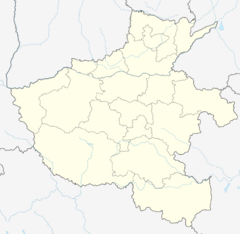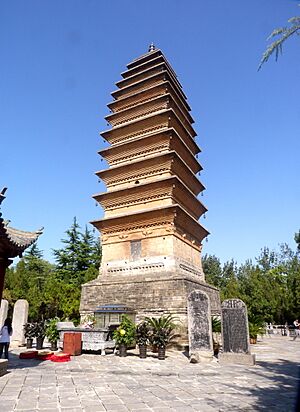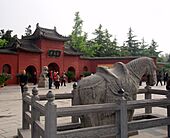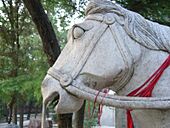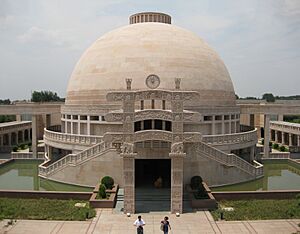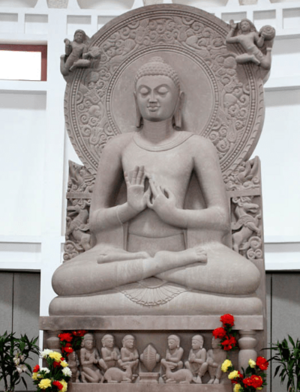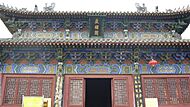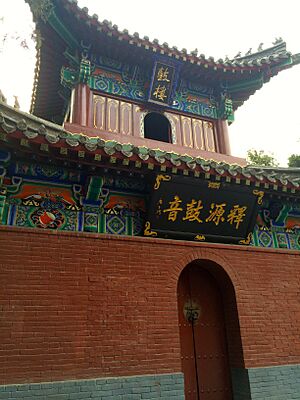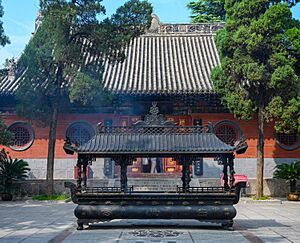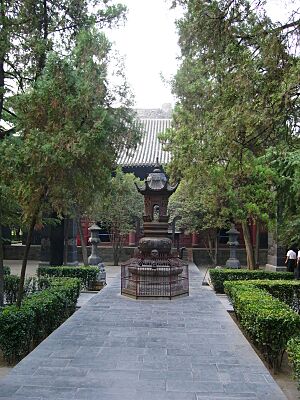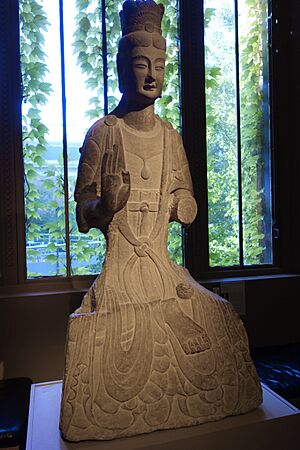White Horse Temple facts for kids
Quick facts for kids White Horse Temple |
|
|---|---|
|
白马寺
|
|

White Horse Temple
|
|
| Religion | |
| Affiliation | Buddhism |
| Location | |
| Location | Luoyang, Henan |
| Country | China |
| Architecture | |
| Architectural style | Chinese architecture |
| Completed | 68 AD |
| White Horse Temple | |||||||||||||||
|---|---|---|---|---|---|---|---|---|---|---|---|---|---|---|---|
| Traditional Chinese | 白馬寺 | ||||||||||||||
| Simplified Chinese | 白马寺 | ||||||||||||||
|
|||||||||||||||
The White Horse Temple (Chinese: 白馬寺) is a famous Buddhist temple in Luoyang, Henan province, China. Many people believe it was the very first Buddhist temple built in China. It was first established in 68 AD. This happened under the support of Emperor Ming during the Eastern Han dynasty.
The temple is located just outside the old capital city walls. It is about 12 to 13 kilometers (7 to 8 miles) east of Luoyang. You can easily reach it by bus from Luoyang railway station. Even though it's smaller than some other temples in China, many followers see it as "the birthplace of Chinese Buddhism." South of the temple, you can find Manghan mountain and the Lucoche River.
The main buildings of the temple are quite old. They were rebuilt during the Ming (1368 to 1644) and Qing (1644 to 1912) periods. The temple was also fixed up in the 1950s. More repairs happened in March 1973 after the Cultural Revolution. The temple complex has many halls separated by courtyards and beautiful gardens. It covers an area of about 13 hectares (32 acres). Signs in Chinese and English explain the Buddhist statues in each hall.
Important statues include Śākyamuni Buddha and Maitreya. Maitreya is often called the laughing Buddha in China. There are also statues of Amitābha and a special Jade Buddha. You can see Bodhisattvas like Guanyin and many arhats. Stone statues of two white horses stand at the entrance. These horses are said to have carried Indian monks to China. Two mythical lions also guard the entrance. The temple has been changed and improved with help from other countries. For example, a project with India finished in 2008. This project added a replica of the Sanchi Stupa and a Sarnath Buddha statue.
Contents
What Does the Name "White Horse Temple" Mean?
When two monks from India arrived in China, they stayed at this temple. The temple was named "White Horse Temple" (simplified Chinese: 白马寺; traditional Chinese: 白馬寺; pinyin: Báimǎ sì; Wade–Giles: Pai2-ma3 ssu4). In this name, Chinese: 白 means "white." simplified Chinese: 马; traditional Chinese: 馬 means "horse." And Chinese: 寺 means "shrine, temple, or monastery."
It's interesting that the emperor chose the word 寺 (pinyin: sì) for the temple's name. This word used to mean a government department. By using it for the temple, the emperor showed great respect. Later, this word became common for all temples. Even mosques started using it. Government departments then stopped using it in their names. So, "White Horse Temple" is the modern way to say it. But at the time, it was more like "White Horse Ministry."
How Buddhism Came to China: The Temple's Story
The story of the White Horse Temple is closely linked to how Buddhism first arrived in China. Here is a popular legend:
Emperor Mingdi had a special dream in 60 CE. He saw a golden person with the sun and moon shining behind them. This person came from the sky and circled his palace. The emperor's advisors told him this person was the Buddha. The Buddha was a saint born in India, to the west of China.
Because of this dream, Emperor Mingdi sent a group of 18 people to India. They went to learn about the Buddha's teachings. In India, they met two Buddhist monks. Their names were Kasyapa Pandita and Bharana Pandita. The monks agreed to return to China with the emperor's group. They traveled on two white horses. They brought important Buddhist texts, like the Sutra of Forty-two Chapters. They also carried Buddha statues and relics.
When they arrived in Luoyang in 67 CE, the emperor was very happy. He was especially pleased with the Buddha statue. It looked just like the golden person in his dream. The monks also performed some amazing acts. This made the emperor believe even more in Buddhism.
To honor the monks and the white horses, the emperor ordered a temple to be built. This temple was named the White Horse Temple. The two monks lived there and translated many Buddhist scriptures into Chinese. They later passed away at the temple and are buried in its first courtyard. After the temple was built, many monks lived there to practice Buddhism.
Early History of the White Horse Temple
The White Horse Temple played a key role in spreading Buddhism in China. In 258, a monk named Po-Yen translated six Buddhist texts into Chinese there. One important text was the Infinite Life Sutra.
Another famous Buddhist translator, Dharmarakṣa, lived at the White Horse Temple. He was active between 266 and 308 CE. He stayed at the temple from at least 289 to 290 CE.
Later, the renowned monk Xuanzang from the Tang dynasty started his journey from this temple. He traveled to India for 16 years (630–635 CE). He wanted to visit the Buddha's homeland. When he returned, Xuanzang became the head monk (abbot) of the White Horse Temple. He stayed there until he died. During his time, he taught and translated many Buddhist scriptures. He skillfully changed the Sanskrit texts into Chinese.
In 1175, a stone tablet near the Qilun Pagoda recorded a fire. This fire had destroyed the temple and an older pagoda about 50 years before. The Qilun Pagoda we see today was built soon after this fire. It was built by an official from the Jin dynasty (1115–1234). This pagoda is 35 meters (115 feet) tall. It has a square base and many eaves, similar to pagodas from the Tang dynasty.
Between the 13th and 20th centuries, the temple was repaired and renovated. This happened during the Ming and Qing dynasties. Major work took place in the 16th century. Some buildings from that time are still standing, though they have been updated.
Modern History and Restoration
Under the People's Republic of China, the temple has seen many repairs. This was especially true between 1952 and 1973. The temple was badly damaged during the Cultural Revolution. Many buildings were burned, and precious items were taken.
In 1973, Prince Norodom Sihanouk of Cambodia visited the temple. Cambodia was a friendly country to China. Prince Sihanouk was a strong Buddhist. He asked to visit the White Horse Temple. This caused a rush because much of the temple was still damaged. Quickly, 2900 artifacts were brought from other palaces and museums in China. These items were secretly moved to the White Horse Temple. The temple was fully restored just for his visit. The newly restored temple impressed the Cambodians. They did not know about the damage that had happened. Premier Zhou Enlai later announced that these artifacts would stay at the White Horse Temple permanently.
In 1992, a new hall was built. It was called the Hall of the Thai Buddha. This was done with help from people in Thailand and China.
India and China's Cultural Connection
The White Horse Temple is very important for the old cultural ties between China and India. The Prime Minister of India, P.V. Narasimha Rao, visited the temple in 1993. Ten years later, in 2003, Prime Minister Atal Bihari Vajpayee also visited.
To make the Buddhist links stronger, India and China signed an agreement in 2005. India agreed to build an Indian-style Buddhist temple. This new temple would be on the west side of the White Horse Temple complex. India would provide the design, building materials, and a Buddha statue. Chinese authorities would provide the land.
A Buddhist shrine, similar to the Sanchi Stupa, was finished in 2008. Its presence at China's first temple shows the connection to Indian Buddhist saints. The new temple looks very much like the Sanchi Stupa. It even has a replica of Sanchi's east gate. A Buddha statue was brought from India. It was placed in the new temple following Indian Buddhist traditions. This temple was built on land given by the Chinese government. The shrine has two floors with round walls. These walls are decorated with paintings. The paintings show scenes from the Jataka tales and the life of Buddha.
The Buddha statue was designed like a 5th-century image from Sarnath. It is placed in the temple's main hall. The president of India, Pratibha Patil, opened this temple on May 27, 2010. The new temple combines features from the respected Indian Buddhist shrines of Sanchi and Sarnath.
Exploring the Temple's Architecture
The White Horse Temple faces south. Its buildings are lined up along a central path. This path starts from the entrance gate. It then goes through several halls and courtyards. The temple grounds cover about 13 hectares (32 acres). A stone archway (paifang) was recently built. It stands 150 meters (490 feet) in front of the original gate. The stone horses at the front are in the Ming style. They represent the white horses that carried the scriptures and monks to China. Between the archway and the gate, there is a pool with fountains. Three stone bridges cross this pool. Two green stone horses stand at the entrance gate. They face each other and date back to the Song dynasty (960–1279).
Inside the temple, signs in English and Chinese guide visitors. These signs explain the statues in each hall. The halls include the 'Hall of Greetings' and the 'Hall of Six Founders'. There is also the 'Hall of Jade Buddha' and the 'Hall of Heavenly Kings'. Other halls are the 'Hall of Mahavira' and the 'Hall of Changing Ge'. The Changing Ge hall holds ancient scriptures.
Behind the main hall is the 'Cool and Clear Terrace'. This is where the original Buddhist texts were translated. This terrace is surrounded by old pine trees and bamboo. It has connected halls. The central building is the Vairocana Pavilion. It was first built during the Han dynasty. The current building is from the Ming dynasty. It has a special roof style with double eaves. Inside, it holds statues of Vairocana Buddha and the Bodhisattvas Manjushri and Samantabhadra. There are also 5,050 wood-carved Buddha statues. These are made from incense ash. The terrace also has the Kunlu Pavilion. Its east and west halls have statues of the two Indian monks, She Moteng and Zhu Falan. They are buried inside the temple gate. The Bell Tower and Drum Tower are in front of their tombs. They were once famous sights in Luoyang City.
In the courtyards, large burners are used for burning incense sticks. This creates a strong, pleasant smell. In the main hall and other halls, altars are filled with offerings. These offerings include fruits from devotees. Colorful tapestries hang from the ceilings. Lighted candles float in basins. All this creates a peaceful and spiritual atmosphere.
The smallest hall is the "Hall of Greetings." It is a newer building. It replaced an older hall that burned down. This hall has statues of three saints from the western paradise (India). Amitabha, the founder, is in the center. He is joined by Guanyin on the left and Mahasthamaprapta on the right.
The "Hall of Six Founders" honors the founders of the Chan sect. Their names are Bodidharma, Huike, Sengcan, Daoxn, Hongren, and Huineng. Bodidharma was the first founder. He came from ancient India. After Huineng, five schools of Buddhism and seven orders were started.
In the "Hall of the Jade Buddha," you can see a statue of the Sakyamuni Buddha. This statue is 1.6 meters (5.2 feet) tall. It is made of jade. A Chinese man living in Burma donated it in 1988. This beautiful statue has a precious stone on its forehead. It was moved to this temple in 1992.
The first large hall is "The Hall of Heavenly Kings." Here, a statue of Maitreya is the main deity. He is known as the laughing Buddha in China. Four heavenly kings stand on either side of Maitreya. Each king represents one part of the universe. Chigua guards the East. Guangmu guards the West. Zengzhang protects the South. Duowen preserves knowledge in the North. There is also a statue of Wei Tuo. He is a high-ranking general and defender of Buddhist law.
The Hall of Changing Ge was built in 1995. It stores many ancient scriptures. It has over ten types of Buddhist texts. An ancient Buddha statue is in the center of this hall. This statue is from the Eastern Han dynasty. It was lost in the early 1900s. But it was later found in Thailand. Two bronze copies were made and gilded. One is in this library, and the other was sent to Thailand.
The Mahavira Hall holds statues of three main Buddhas. The central image is the Sakyamuni Buddha. On his left is Bhaisajyaguru. On his right is Amitābha. Two heavenly generals, Wei Tuo and Wei Li, stand next to them. Statues of the Eighteen Arhats are along the sides of the hall. All these statues were made from ramie-cloth during the Yuan dynasty. The walls have carvings of ten thousand Buddhists.
In the Main Hall, there are three statues on the altar. The central one is Sakhyamuni Buddha. He is flanked by Manjushri and Samantabhadra. A very large bell is also near the altar. It weighs over 1 tonne (2,200 pounds). This bell was installed during the Jiajing Emperor's rule in the Ming dynasty. It is struck during prayers. The inscription on the bell says: "The sound of the Bell resounds in Buddha's temple causing the ghosts in Hell to tremble with fear."
The monks' living area is in a special pagoda. It is called the "Qiyun Ta," or Qiyun Pagoda. You can reach it by crossing a garden and a bridge. This pagoda was built in the 12th century. It is a 13-tiered, 25-meter (82-foot) high brick tower. It has been renovated many times. The tomb of the famous Tang dynasty official Di Renjie is also in the eastern part of the complex.
The temple is open to visitors. However, security is present. Monks living there must carry an ID card.
Cultural Treasures
Maitreya Statue
A stone statue of Maitreya from the 6th century was stolen. It ended up in the United States. Now, it is kept at the Museum of Fine Arts, Boston.
Luoyang Peony Festival
The Peony Festival (mudan huahui) is an important flower festival. It takes place in Luoyang every year from April 10 to 25. Many people come to the city and the White Horse Temple for this event. A legend explains why this festival is celebrated. Empress Wu of the Tang dynasty ordered peony flowers to bloom in winter. But the flowers did not obey her. The empress became very angry. She ordered the peony flowers to be sent away from Xi'an to Luoyang. This banishment is what the Peony Festival in Luoyang celebrates.
See also
- Chinese Buddhism
- Horse in Chinese mythology


